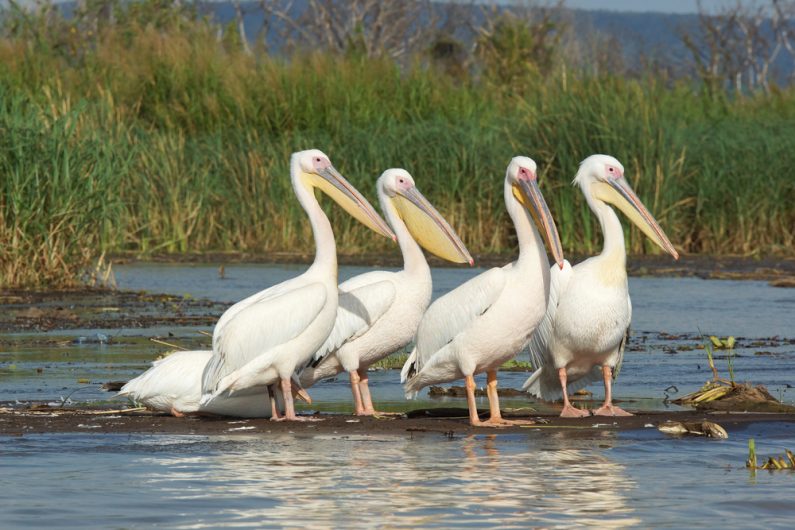Proposed mainly for the prolific of the Nechisar plains, especially Burchell’s Zebra; other features includes spectacular scenery; large number of crocodiles and hippopotamus in the lakes Chamo and Abaya.
Species recorded: 84 mammals and 342 birds
Charismatic species: Burchell`s Zebra
Location: the Nechisar National Park is located south of Addis Ababa at the coordinate between N6000’ and E37045’. The area is with an altitude range of 1,108-1,650m asl. The Head Quarter is situated at 500km from Addis Ababa near Arbaminch town.
Rainy Season: the rainfall in the park averages about 800mm a year. The main wet season is April to June with a second wet period in September- October. The driest season is December to February.
Temperature: ranges from 36-390c in December to February. The lowest are 20-210c in April- June.
Ecological Zone: Rift Valley
Vegetation Type: Savanna characteristics such as grassland, ground water forest, wetlands and bushland.
Major wildlife species: include Burchell’s Zebra, Swayne’s Hartebeest, Greater Kudu, Grant’s gazelle, Hippopotamus, Crocodile, Aubis Baboon, Black-backed Jackal; Side striped jackal, Bat-eared fox, Warthog, African hunting Dog, Guenther’s Dikdik, Lion and leopard. The park is also rich in avifauna content including the north white-tailed bushlark.
Endemic mammals: Swayne’s Hartebeest, Scott’s hairy Bat, Crocidura phaera, White footed Rat, Ethiopian grass Rat and Hinde’s Bat
Endemic birds: Nechisar mightjar
Species recorded: 84 mammals and 342 birds
Charismatic species: Burchell`s Zebra
Location: the Nechisar National Park is located south of Addis Ababa at the coordinate between N6000’ and E37045’. The area is with an altitude range of 1,108-1,650m asl. The Head Quarter is situated at 500km from Addis Ababa near Arbaminch town.
Rainy Season: the rainfall in the park averages about 800mm a year. The main wet season is April to June with a second wet period in September- October. The driest season is December to February.
Temperature: ranges from 36-390c in December to February. The lowest are 20-210c in April- June.
Ecological Zone: Rift Valley
Vegetation Type: Savanna characteristics such as grassland, ground water forest, wetlands and bushland.
Major wildlife species: include Burchell’s Zebra, Swayne’s Hartebeest, Greater Kudu, Grant’s gazelle, Hippopotamus, Crocodile, Aubis Baboon, Black-backed Jackal; Side striped jackal, Bat-eared fox, Warthog, African hunting Dog, Guenther’s Dikdik, Lion and leopard. The park is also rich in avifauna content including the north white-tailed bushlark.
Endemic mammals: Swayne’s Hartebeest, Scott’s hairy Bat, Crocidura phaera, White footed Rat, Ethiopian grass Rat and Hinde’s Bat
Endemic birds: Nechisar mightjar

Major Physical/geological features: lakes Abaya and Chamo, Rift valley escarpment, Kulfo ground water forest and Filwoha hot spring
Tours: the park ranks in the experience of many visitors as one of the most beautiful paces in the tropical savannahs. It is located on an outstandingly scenic part of the Rift Valley floor between two lakes Abaya and Chamo The Amharic ‘nech sar’ literally means white grass and refers to central grassy plains which are always associated with Burchell’s Zebra and the park’s most striking features. The escarpment stretched between Chamo and Abaya lakes is locally referred as a “bridge of God” giving rise to a legend both lakes was one entity.
Wonderful hikes can be made along all sorts of routes, especially among kulfo ground water forest to discover the origin of forty springs set at the base of the cliff. There is a pool associated with these springs for additional enjoyment by swimmers.
THE HOT SPRING at the southeast part of the park is also another attraction site, together with a fringing forest of Sermalle River.
Lake tours: lake tour on both lakes of Chamo and Abaya are among the best elsewhere in Ethiopia. Lake Excursion provides with a spectacular large population of crocodiles (especially crocodile market of Lake Chamo) and hippopotamus. Both lakes are also great for birdlife and sport fishing.
Game drive: along the main tourist route to the central plain of the park, wild animals such as ground squirrel, warthogs, Greater Kudu and Various savanna birds can be encountered. A spectacular game view is exploited at the central plain owith a fascinating population of Burchell’s Zebra, Graint’s Gazelle and Swayne’s hartebeest.
Tours: the park ranks in the experience of many visitors as one of the most beautiful paces in the tropical savannahs. It is located on an outstandingly scenic part of the Rift Valley floor between two lakes Abaya and Chamo The Amharic ‘nech sar’ literally means white grass and refers to central grassy plains which are always associated with Burchell’s Zebra and the park’s most striking features. The escarpment stretched between Chamo and Abaya lakes is locally referred as a “bridge of God” giving rise to a legend both lakes was one entity.
Wonderful hikes can be made along all sorts of routes, especially among kulfo ground water forest to discover the origin of forty springs set at the base of the cliff. There is a pool associated with these springs for additional enjoyment by swimmers.
THE HOT SPRING at the southeast part of the park is also another attraction site, together with a fringing forest of Sermalle River.
Lake tours: lake tour on both lakes of Chamo and Abaya are among the best elsewhere in Ethiopia. Lake Excursion provides with a spectacular large population of crocodiles (especially crocodile market of Lake Chamo) and hippopotamus. Both lakes are also great for birdlife and sport fishing.
Game drive: along the main tourist route to the central plain of the park, wild animals such as ground squirrel, warthogs, Greater Kudu and Various savanna birds can be encountered. A spectacular game view is exploited at the central plain owith a fascinating population of Burchell’s Zebra, Graint’s Gazelle and Swayne’s hartebeest.










